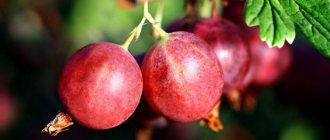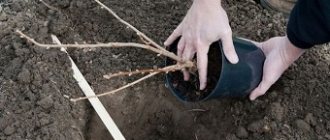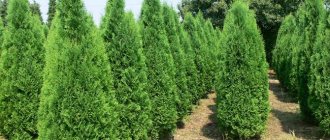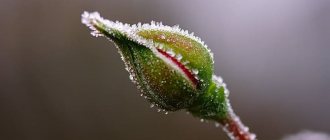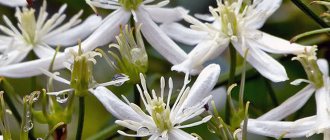It is necessary to begin preparing juniper in the fall for a long winter in mid-September. The set of measures includes: protecting the plant from drought, sanitary pruning in the fall, and fertilizing. It is also important to cover the juniper to protect the shoots from snowbreaker, frost and sunburn. However, it is important to know some points about caring for conifers in the autumn and how to properly prepare for wintering in order to avoid common mistakes and not harm the plant.
Juniper seedlings can be purchased at a nursery or dug up in the forest
How to plant juniper in the fall
When choosing a planting time, you should take into account the important feature of this conifer - it does not build up the root system throughout the entire season, but only in early spring and mid-summer. During hot and dry periods, replanting bushes in open ground is not recommended, since the plant may not take root and die. Therefore, experts advise planting juniper in autumn or early spring.
The age of seedlings should not exceed 3-4 years. As practice shows, older specimens take root less well and take longer to take root in a new place. However, this is quite possible, and below is a video of planting juniper in the fall with minimal damage to the tree.
When to plant juniper in the fall
Experienced gardeners believe that the most suitable time for planting is late autumn (late October - early November). At this time of year, the air temperature during the day fluctuates between +10-12 °C, and at night does not fall below +5 °C, which are optimal conditions for transplanting juniper in the fall. The plant will calmly endure winter frosts, and with the onset of early spring it will begin to actively grow its root system.
Site selection and soil preparation
When choosing a permanent location, you must remember that the plant does not react well to its change, so it is important to plant juniper correctly the first time in the fall. It is important that the site meets the following criteria:
- was spacious and open;
- the distance to neighboring trees is at least 1.5-2 m;
- the place should be well lit throughout the day.
If these criteria are neglected, the juniper will quickly lose its decorative appearance and will look stunted and sick.
In addition, it is important to pay attention to the composition of the soil, since each species needs different soil:
- Siberian varieties prefer sandy;
- Central Asian, as well as Cossack juniper, require additional liming;
- Virginian is recommended to be planted in clay soils.
And although most varieties thrive in universal soils, it is better to find out at the nursery when purchasing a seedling the recommended soil composition for the young plant you are purchasing.
Step-by-step guide to planting junipers in the fall
The process of planting seedlings in open ground in the fall is simple and even a novice gardener can easily cope with the task. However, you should strictly follow the instructions so that the plant is guaranteed to take root and feel good in its new place. Description of step-by-step technology for planting juniper in the fall:
- Preparing the planting hole. The diameter and depth of the hole should be 2-3 times greater than the size of the root system (earthen ball) of the seedling. For a 3-4 year old juniper, a 50x50 cm hole is usually enough.
- Drainage (broken tiles, crushed stone) 15-20 cm high is laid on the bottom. On top of it is a layer of a nutrient mixture consisting of 1 part sand, 1 part turf and 1 part peat. 300 ml of nitroammophoska is also added there. Next, the planting hole is left for 2-3 weeks, allowing the soil to settle naturally.
- Planting a seedling. After three weeks, you can begin planting the young plant in the prepared hole. To do this, the seedling is placed in the center of the planting hole and covered with soil. In this case, it is important that the root collar is level with the upper edge of the hole, and if the bush is older than four years, 7-10 cm higher.
- Watering and mulching. Immediately after planting in the fall, juniper must be watered abundantly (approximately 15 liters of water in each hole). After this, be sure to mulch the root circle with a layer of humus, sawdust or pine needles. This will ensure the preservation of moisture and protect the seedling from dehydration in a stressful situation for it.
Following the algorithm for planting juniper in open ground in the fall will help it survive the winter with minimal damage.
Juniper care in autumn and winter
Juniper is a hardy and unpretentious plant and does not require special care in the fall. Specimens transplanted in October need watering and irrigation until the weakened roots take root and go deeper into the ground. Bushes and trees that have been growing in a permanent place for many years do not need additional watering, drawing the necessary moisture from the soil.
Caring for juniper in the fall, as well as preparing for winter, comes down to watering (young representatives), sanitary pruning, autumn feeding, preventive treatment, mulching and sheltering shoots from frost.
How to water juniper in autumn
Seedlings planted in autumn require mandatory watering throughout the year. In autumn and spring, the plant should not be watered very abundantly. In summer, when it is hot, more often, but not more than once every two weeks. From the second year on, the bushes are not watered in the fall, although the plants respond favorably to spraying the shoots.
It is necessary to wet the entire root circle - this is where the thin roots that absorb moisture are located
Feeding schedule
Juniper is fed twice a year: in the spring - during the period of active growth, and in September - so that it has strength for the winter. It is especially important in the fall to fertilize young plants with fragile root systems.
Traditionally, junipers are fed with compost, to which the plants respond well because it imitates natural forest soil. To do this, loosen the soil under trees or bushes and lay a layer of compost 10-12 cm high, burying it slightly into the soil, after which it is watered abundantly.
Warning! You cannot use an infusion of bird droppings or mullein to feed juniper. Such fertilizers burn the root system of the plant, which leads to its death.
When choosing mineral fertilizers, it is important to remember that juniper does not need nitrogen in the fall, but magnesium is needed, since by this time the reserves of the microelement in the soil are depleted. Also, once a year they fertilize with nitroammophoska at the rate of 40 g per plant.
Pruning juniper in autumn
During autumn pruning, excess growth and shoots growing inside the crown are cut off, and dry and diseased branches are also removed. The process of cleaning bushes should begin no earlier than the beginning of October, however, long before the first frost.
Pruning is carried out on a cloudy day or in the evening. Important! You can do a sanitary pruning of juniper in the fall at a temperature not lower than +4 °C.
At lower temperatures, fresh cuts heal less well, which is dangerous for the plant, since various bacteria and pests quickly settle in the wounds.
Since junipers have a low growth rate and produce only 10-12 cm of growth per year, pruning should be done sparingly - no more than 15-20% of the annual growth.
Preventative treatments
Preventative treatment in the fall is carried out to protect shoots from fungal infections and pests. Fungicides are used to control fungi, and insecticides are used to kill pests.
In the fall, the procedure is carried out in several stages, since harmful insects most likely managed to lay eggs, and the fungi sowed spores. At the same time, you need to work with pesticides carefully, following the instructions exactly, otherwise you can cause irreparable harm to the plant.
Mulching
Despite the fact that juniper overwinters well, it is still worth taking care of its protection from severe frosts. Mulching the root circle in the fall is necessary not only to conserve moisture, but also to protect the thin roots located in the upper layer of soil from frost.
Even if the crown suffers from low temperatures in winter, bushes and trees with a covered root system will fully recover. The mulch layer should be at least 12-15 cm, and pine needles, fallen leaves, and hay are usually used as bedding.
Preparing juniper for winter
In addition to protecting the root system from frost, it is important to take care of juniper shoots in winter. They must also be protected from exposure to low temperatures, snow and sunburn. The fact is that at the end of winter the sun begins to become noticeably hot, and the juniper, which senses the climate change, opens its stomata - the plant begins to actively breathe. At the same time, the root system is still dormant, and the shoots do not receive the required amount of moisture, as a result of which they dry out. Therefore, it is important to cover the juniper in the fall in order to minimize possible damage and maintain the integrity of the crown.
An ephedra affected by sunburn in winter takes a very long time to recover
How to cover juniper for the winter
It is imperative to cover junipers planted in autumn for the winter, as well as all young plants under four years of age. For low-growing varieties and small bushes, it will be enough to cover them with pine spruce branches, which will perfectly protect the branches from exposure to ultraviolet radiation and frost. Tall juniper is wrapped with a special covering material (agrofibre, spunbond) or burlap.
Important! It is necessary that the covering material be breathable, and the plant is not packed from the top to the ground - the lower part remains slightly open for ventilation.
Older trees are better able to withstand long and cold winters. However, to save the branches from breaking off under the weight of fallen snow, it is recommended to tie them or make special frames on which the mesh is stretched.
Twine will protect tree branches from snowbreakers
Proper care of juniper in winter will help preserve the decorative appearance of the conifer and avoid damage to the crown. The plant will safely overwinter and retain its beauty and health.
Autumn work front
Active preparation of shrubs for winter begins in the fall. Before covering the juniper, the necessary agrotechnical measures are carried out: moisture-recharging watering, pruning, treatment against pests and diseases.
Watering and spraying
The need for watering depends on the weather: if autumn is rainy, then the plant does not need additional moisture. Otherwise, if the hot summer turns into a mild, dry autumn, it is necessary to water the juniper once every 2 weeks. For a medium-sized bush you will need about two ten-liter buckets of water. Immediately before the shelter, 4–5 buckets of water are poured into the tree trunk area, which is better to loosen a little.
Read also: What family does the nightshade belong to?
A layer of mulch will help retain moisture and provide ventilation. Spraying has a beneficial effect on the appearance and health of the plant. To do this, you need to use settled water at room temperature. To prevent the bush from being damaged by the sun's rays, which, together with moisture, can burn out the needles, it is recommended to carry out the procedure early in the morning or after sunset.
Trimming
Autumn pruning is carried out in mid-November. During this process, dry and damaged branches are removed. If necessary, the crown of the bush is formed during the process. However, you should be careful when pruning: the shoots grow back slowly. It is impossible to remove too much of the bush at once; it will not have time to recover before winter.
Protective measures
The most ardent enemies of juniper are rust and aphids. The dust fly and spider mite can be no less dangerous. Treating the bush with Abiga-Peak will help prevent the development of the disease and cure the plant. For full results, you will need 4 sprayings with an interval of 10 days. The insecticidal preparations “Fitoverm” and “Fufanon” cope well with pests.
Mistakes made when caring for juniper
Despite the fact that caring for juniper is simple, many gardeners make common mistakes that harm the plant:
- improper organization of watering. Juniper cannot be moistened abundantly, as this leads to waterlogging of the soil and rotting of the root system of the bush;
- feeding in late autumn with nitrogen complexes. You need to fertilize at the end of September so that the nutrients do not have time to spread throughout the entire bush. Otherwise, this stimulates the active growth of young shoots, which leads to freezing of the bush in winter;
- excessive pruning. Excessive removal of shoots leads to stopping the growth of the entire plant and loss of decorativeness;
- incorrectly selected material for shelter for the winter. You cannot use polyethylene; it is better to take burlap or special breathable material. Condensation forms under the oilcloth, which increases humidity and the risk of fungal infections;
- use when processing cuts of garden varnish. After sanitary cleaning, the wounds do not need to be treated with anything; they will heal naturally.
To grow healthy and properly formed juniper on your site, you don’t need to make any special efforts. However, it is important to monitor the condition of the plant, evaluate its appearance in order to notice and correct your mistakes in caring for the conifer in time.
Video: covering conifers for the winter
By following a number of simple recommendations for preparing junipers for wintering, you will be able to avoid damage to the crown and loss of decorativeness. The shrub will overwinter well and maintain a healthy appearance.
Juniper in the fall requires some attention. In order for the bush to please you all year round with its rich, juicy greenery and pleasant aroma, it should be properly prepared for winter. If for some reason the plant turns yellow and does not take root, you should listen to the advice of experienced gardeners. By following simple recommendations, you can achieve good results.
Read also: Dried lemon, what to do


